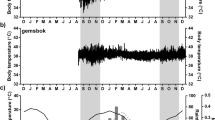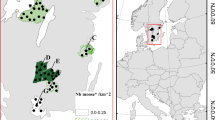Abstract
ORYX (Oryx beisa) and Grant's gazelle (Gazella granti) survive droughts in hot semi-deserts, apparently without drinking. Zebu cattle (Bos indicus), however, must drink frequently to survive. The actual water requirements of the three species are 2–4 per cent of their body weight per day1. All eat dry food, which at mid-day contains only 1 per cent free water. Where do the antelopes get the water they require ? Schmidt-Nielsen2 suggested that hygroscopic plants might be an important source of water for nocturnal animals. I collected plants which were eaten by antelopes during a drought, determined the rate at which the dry leaves gain water at temperatures and humidities measured during the drought, and calculated the amount of water available to the antelopes if they feed at night.
This is a preview of subscription content, access via your institution
Access options
Subscribe to this journal
Receive 51 print issues and online access
$199.00 per year
only $3.90 per issue
Buy this article
- Purchase on Springer Link
- Instant access to full article PDF
Prices may be subject to local taxes which are calculated during checkout
Similar content being viewed by others
References
Taylor, C. R., Symp. Zool Soc., 21, 195 (1968).
Schmidt-Nielsen, K., Desert Animals, Physiological Problems of Heat and Water (Clarendon Press, Oxford, 1964).
Author information
Authors and Affiliations
Rights and permissions
About this article
Cite this article
TAYLOR, C. Hygroscopic Food: a Source of Water for Desert Antelopes?. Nature 219, 181–182 (1968). https://doi.org/10.1038/219181a0
Received:
Published:
Issue Date:
DOI: https://doi.org/10.1038/219181a0
This article is cited by
-
Antelope adaptations to counteract overheating and water deficit in arid environments
Journal of Arid Land (2022)
Comments
By submitting a comment you agree to abide by our Terms and Community Guidelines. If you find something abusive or that does not comply with our terms or guidelines please flag it as inappropriate.



